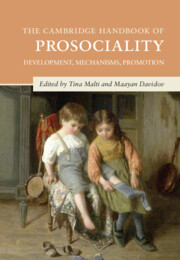Book contents
- The Cambridge Handbook of Prosociality
- Cambridge Handbooks in Psychology
- The Cambridge Handbook of Prosociality
- Copyright page
- Dedication
- Contents
- Figures
- Contributors
- Part I Development of Prosociality
- Part II Antecedents and Mechanisms of Prosociality
- 11 The Motives of Prosocial Behavior
- 12 Morality, Values, and Prosociality across Development
- 13 Emotions and Prosociality
- 14 Social-Cognitive Development and Early Prosocial Behavior
- 15 Temperament and Prosocial Behavior
- 16 Gender and Prosocial Development
- 17 Assessing Prosociality
- Part III Development of Prosociality in Context
- Part IV Applications
- Index
- References
14 - Social-Cognitive Development and Early Prosocial Behavior
from Part II - Antecedents and Mechanisms of Prosociality
Published online by Cambridge University Press: 25 May 2023
- The Cambridge Handbook of Prosociality
- Cambridge Handbooks in Psychology
- The Cambridge Handbook of Prosociality
- Copyright page
- Dedication
- Contents
- Figures
- Contributors
- Part I Development of Prosociality
- Part II Antecedents and Mechanisms of Prosociality
- 11 The Motives of Prosocial Behavior
- 12 Morality, Values, and Prosociality across Development
- 13 Emotions and Prosociality
- 14 Social-Cognitive Development and Early Prosocial Behavior
- 15 Temperament and Prosocial Behavior
- 16 Gender and Prosocial Development
- 17 Assessing Prosociality
- Part III Development of Prosociality in Context
- Part IV Applications
- Index
- References
Summary
This chapter reviews recent research on the relation between early social-cognitive development and the ontogeny of prosocial behavior. In particular, it focuses on action understanding, cognitive perspective taking, affective perspective taking, social learning, reciprocity, and strategic behavior, as well as self-related cognitive processes. For each aspect, central theoretical considerations and an overview of current empirical findings are presented. The chapter concludes with a discussion of implications of these lines of research for the promotion of early prosocial behavior.
Keywords
- Type
- Chapter
- Information
- The Cambridge Handbook of ProsocialityDevelopment, Mechanisms, Promotion, pp. 275 - 299Publisher: Cambridge University PressPrint publication year: 2023



